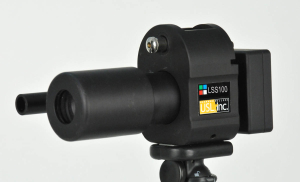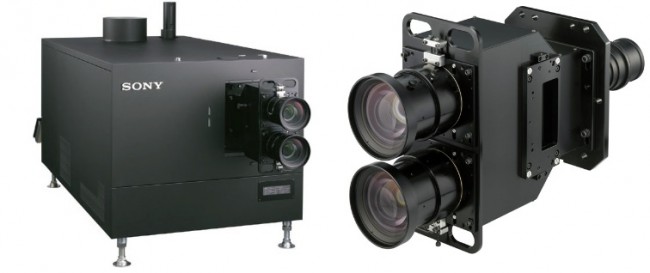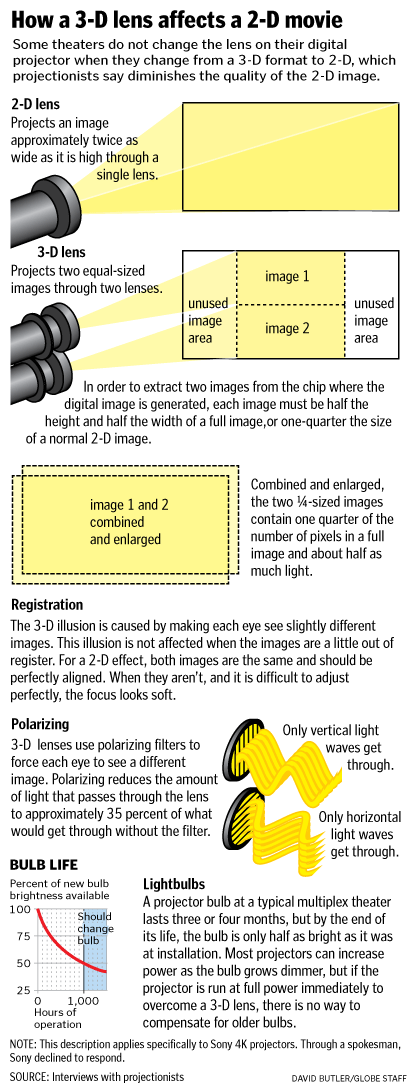As we understand it, the replacement of the Xenon bulb with lasers makes a better overall match to the etendue limits of the chip. By their nature, lasers have a very small emission area and a very narrow emission angle. Therefore, they can use less power to put more light at the proper etendue angles of the chip, and can therefore allow the chip to put more light through the projector’s lens. They also allow the use of lenses with higher f#, which in the real world means less expensive lenses.
The most notorious problem with lasers thus far is described as “speckle”, due in large part to the extreme narrow band of color that the laser emits. This speckle is known to cause not only color distortions, but unless reduced below obvious levels can also cause fatigue and even nausea and headaches. Lasers also require active temperature stabilization which in many cases requires a lot of power.
Against this background, we introduce and thank Bill Beck for this opportunity to ask 3Questions.
Bill Beck is a founder of Laser Light Engines Inc., based in southern New Hampshire near the famous R&D centers of Boston (MIT, Harvard, BU Photonics). Their website is polite but also light on detail – one suspects that they were in research mode with little to say, then exploded into development mode and have been too busy to say much.
Recent news items have announced a relatively large infusion of capital, both from typical venture capital sources, and also from the IMAX Corporation to develop a laser light source for their digital projectors. Secondly, they have helped found an industry group with Sony, IMAX and others – Laser Illuminated Projection Association (LIPA) – to help regulatory agencies differentiate the established needs of protecting the public who watch laser-light shows (and which require FDA exemptions for each show) from what they are hoping will be a new category called “laser-illuminated projection”. There is also word of another industry association that is trying to pin down how to quantify speckle: how to measure and what it does.
Separately, Sony has announced their research and development of laser engines (links below) and there are rumors of assistance from a French company which might imply that their development is not as advanced as the Sony website seems to indicate. Kodak also showed their first versions of a laser system for digital cinema which they speak of as being two years away from application.
Q1: We understand that the initial Laser Light Engine concept is to supply a module that replaces the Xenon light engine. Would that include replacing the optical block of condenser lenses and the prism?
Bill Beck: We see this as a multi-step process. In the future, there won’t be a need for a condenser and splitter as our laser makes narrow band RGB which could easily be delivered directly to the chips. But the optical block of the typical projector, which includes these items, is not part of the module that we can easily modify after the fact. We conceive that our first product offerings will be packages, adapted for each brand and model, which will work with existing optical blocks. It will be a one-time replacement of the lamp and reflector housing that that won’t require a great deal of customer difficulty.
Q2) The optical block is an expensive part of a projector, and your lasers must have costs associated compared to a bulb and the reflective surfaces they replace. Where is the savings?
A2) As you know, the human visual system responds to a very narrow band of wavelengths, and in that band, to some frequencies more than others. The typical xenon bulb is quite efficient compared to other choices. For example, they are quite white balanced. But they still generate significant amounts of infrared and ultraviolet light, which is all wasted energy (typically, ~95% of the energy created) and which requires special designs to eliminate both the heat and the O3 (ozone) created.
And, when you think about it, the design of RGB laser systems won’t require all the interband light between the frequencies needed to mix colors – more wasted light. Plus, the basic laws of physics apply, such that the light is incredibly bright at the arc point, but the power decreases inversely proportional at the square of the distance. By the time the light gets bounced around and focused to the very narrow slit cone the chip can accept, an incredible amount of the light is wasted and the energy used to create it is for naught.
So, yes. In comparison, it takes significant power to create the laser light, but we can generate just to amounts that we need, at the frequencies that we need, and supply it to the chip at the angle that it needs. This allows us to bring an exact ratio of power (which isn’t equal amounts of R and G and B by the way) at the specific frequencies we choose (615/546/455 nanometers.)
The nature of high pressure bulbs (25 atmospheres in an IMAX bulb) also requires them to be replaced quite often, often before their time – we’re talking 100’s, not 1000’s of hours of use. At 5 movie showings a day, 2 hours each, a thousand hours can be reached in 3 months. Because the special glass, and coatings on the glass, get bombarded with such high amounts of energy they become brittle – an exploding bulb can cause 10’s of thousands in damage. They are not inexpensive, so exhibitors have to turn them on and off between each show. Still, a single high duty-cycle projector might use 10,000 dollars worth of bulbs per year, or more.
While the first generation units won’t have all the power consumption reduction optimized, we estimate that we will ultimately get 2X the light to the screen for the same power consumption, without considering the reduced requirements for AC pulling heat away (which is not insignificant.)
Finally, and also not insignificant, our tests show that the system can use high f# laser input and achieve 4000:1 sequential contrast with DLP and 3300:1 with LCOS. With the appropriate f# projection lens, the contrast ratio could go even higher.
It is premature for us to speak about projected pricing for our systems. But even apart from direct costs, we feel that offering a constant source of more energy efficient light, which won’t required a projectionist to suit up in full-body protective clothing every 3 months, will bring advantages in every column.
Q3) It is hard to decide on the third question. Lumens per watt of RGB power, input v output to the screen, or how you got the speckle out, or whether you mean all the speckle or just enough that we don’t notice…or should we ask about what you imply about this multi-step evolution, or what this means for less expensive lenses or what the implications are for 3D, both for more light and, for example, we understand that lasers can, by their nature, coherently spin photons in one direction then another, obviating the need for expensive 3D solutions external to the projector. Please take your pick, but please keep it simple. It took me 20 hours of research just to understand etendue.
A3) Yes, the light people do speak in tongues sometimes. The same effect will often have a different name depending on if you are looking from the source point or if you are looking from the receipt point. I’m an optical fibre guy myself, so I’ll start with our concept and try to keep it in one language.
We speak in terms of lumens per beamliine. In the first system that we propose there can be up to 7 beamlines, each with about 30,000 lumens coming out, which combined, that is about 200,000 lumens going toward the chip and getting 60-100,000 lumens out. Depending on the projector efficiency, that is at least 2 times and approaching 3 times the brightness of a big (6Kw) Xenon lamp.
Our research shows that because of the low etendue of the source, we can keep scaling up, which has been a problem for digital cinema. As you alluded, lamp technology could not scale much further. Even with larger chip sizes, there was only minimal brightness gain in the system. With the ability to further cool the chips, we can foresee putting 3 times the light through each optical cable – that’s about 80k lumens per beamline; about 250 optical watts of white balanced of RGB light to the projector. Looking at this another way, that is about 5 times brighter than the brightest Xenon powered digital projector. [Editor’s note: Wow! Bill Beck’s note: Again, that will require not insignificant work to keep the chips cool.]
As far as alternating polarization of the photons pre-chip, that is another benefit of lasers, and the implications are huge…but it will take some work with the chip engineers. That subject can take up 3Questions on its own.
Links:
Sony Insider » The Science Of The Laser Projector
Sony Develops Highly Efficient RGB Laser Light Source Module for Large Screen Projectors
Sony Insider » Sony Details New RGB Laser Light Source Module For Projectors
Kodak Laser_Projection_Technology; Large Display Report article.pdf
KODAK Advances Lasers’ March on DCinema
Display Daily » Blog Archive » News on the Laser Cinema Front
 Importantly, it is also a networked device, making it possible for theater owners to monitor auditoriums continuously from a Network Operation Center (NOC) anywhere in the world, providing instantaneous monitoring of luminance, chromaticity, and SPL data.
Importantly, it is also a networked device, making it possible for theater owners to monitor auditoriums continuously from a Network Operation Center (NOC) anywhere in the world, providing instantaneous monitoring of luminance, chromaticity, and SPL data.



